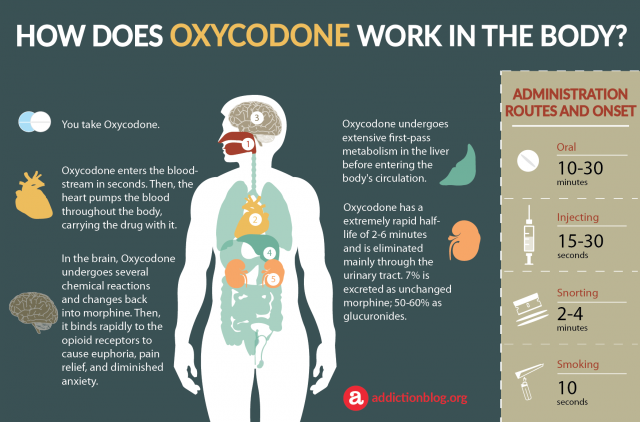The High Risk Pain Reliever
Oxycodone is a semi-synthetic opioid, a white, odorless crystalline powder. It’s synthesized from the opiate alkaloid thebaine, which is derived from the poppy plant. This pain reliever is effective for short term pain relief, but carries a high risk of addiction when not used under strict medical guidance. Even the FDA oxycodone label states:
WARNING: OxyContin is an opioid agonist and a Schedule II controlled substance with an abuse liability similar to morphine.
In the long run, oxycodone is not beneficial to the body; quite the opposite. In some cases, long-term use can result in a paradoxical increase in the perception of pain, called hyperalgesia. More on hyperalgesia in this 2011 article published in the medical journal, Pain Physician. These are some additional risks of prolonged oxycodone use:
- central nervous system depression
- headaches
- irregular heart rate
- physical dependence
- respiratory problems
- seizures
- sensitive stomach
In the following oxycodone infographic we present the effects oxycodone has on each organ of the bodyseparately. We visually show the dangers oxycodone may cause to your mind and body. You are welcomed to post any questions you might have regarding oxycodone effects on the body in the comment section at the end. We always try to provide you with a personal and prompt response.
How Does Oxycodone Work In The Body?
1. YOU TAKE OXYCODONE: Oxycodone can be taken: orally, intranasally, intravenously, or by inhalation. Be aware that any method of oxycodone use without doctor’s consultation is considered abusive and dangerous.
2. STOMACH: The positive pain reducing effects of oxycodone come with a number of unwanted side effects. It is possible that people with a sensitive stomach, those who have ulcers feel stomach pain, or stomach cramps after taking Oxycodone orally.
3. NOSE: Those who abuse Oxycodone by snorting it, risk harming their nasal passages.
4. LUNGS: In case you chronic lung problems, than taking Oxycodone might cause some respiratory issues. Inhaled oxycodone is especially damaging to the lungs. Using Oxycodone even regularly can reduce breathing rates and volume. This can lead to decreased blood oxygen and higher carbon dioxide levels.
5. HEART: According to a study by the Archives of Internal Medicine, Oxycodone can cause damage to the heart cells when taken orally. The latest medical studies indicate that people who use Oxycodone are twice as likely to have a heart attack.
6. BRAIN: Oxycodone acts on the brain by activating opiate receptors in the central nervous system. The end result is the effect of analgesia and decreased sensations of pain. Because of the high that this opioid creates in the brain, users are exposed to the risk of addiction.
7. LIVER: Oxycodone alone does not induce damages to the liver. But when oxycodone is in a combination with acetaminophen, it can be dangerous to the liver in cases of drug overdose.
8. KIDNEYS: After Oxycodone is metabolized inside the liver, it proceeds to kidney filtration, before being eliminated through the urine. Oxycodone does not cause any direct toxic effects on the kidneys.
Oxycodone Dosage
Oxycodone is available in:
Extended-release (ER):
- Oxycodone hydrochloride ER tablets: 10 mg orally every 12 hours.
- Oxycodone (base) ER capsules: 9 mg orally every 12 hours with food for opioid non tolerant.
Immediate-release (IR):
- Initial dose 5 – 15 mg orally every 4 to 6 hours on a regular basis.
NOTE HERE: Doses should be adjusted individually. In order to avoid the risk of overdose or severe health damages it’s best to adjust your dosing with a doctor.
Did We Miss Anything?
Did you found the necessary information you were looking for? In this infographic, we tried to give a closer look at what happens to Oxycodone the minute you take it. If you do have anything else you’d like to learn the answer to, please post your question (s) in the comment’s section below. We try to provide a personal and prompt response to all legitimate inquiries.









Related Posts